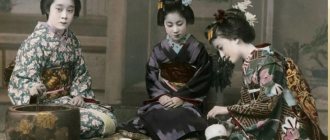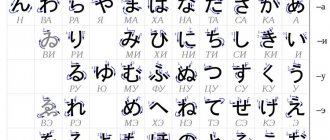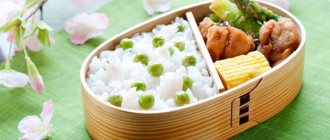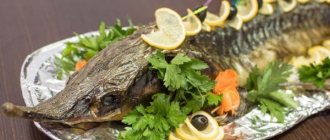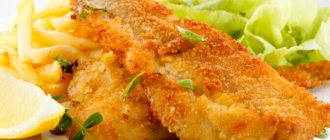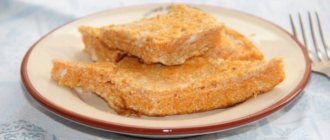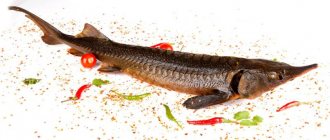Japanese cuisine is both beautiful and mysterious, attractive and incomprehensible - like the whole Land of the Rising Sun. The most famous oriental dishes in our country are sushi, sashimi and rolls. However, the cuisine of the Far East is not limited to them only. The Japanese cook delicious noodles and make original dishes from seafood and different types of meat.
Japanese cuisine is delicious and beautiful
Features of Japanese cuisine
Japanese food is not just food for the body, but a delight for the eyes. Cuisine of the Land of the Rising Sun:
- requires a reverent attitude to form and color;
- includes the concept of seasonality and appropriateness to weather and period of year;
- puts the natural taste and appearance of ingredients at the center;
- served in small portions and small pieces that can be eaten with chopsticks or hands;
- necessarily includes green tea accompanying the main meal.
Traditional dishes are prepared from fresh ingredients, avoiding food that has been stored for a long time (with the exception of sauces and rice). Many recipes include seafood.
An important feature of Far Eastern cuisine is the association of food and season. Each season corresponds to a set of delicacies. Taking this association into account is just as important as using only fresh produce. For example, in autumn, carrots are cut into the shape of maple leaves for soup, and spring desserts are decorated with sakura flowers.
Japanese dishes cannot be called heavy. Food is served in small portions. Most traditional foods are low-calorie. However, there is no threat of hunger: a wide variety of dishes and snacks are served at the table at the same time, so everyone will leave full. In former times, an aristocratic meal included up to 20 courses, and the classic division into hot, cold, soup, main course, and dessert was not used. The Japanese distinguish the beginning, middle and end of a meal. The order of consumption is at the discretion of the diner.
Japanese food is tasty and dietary
What do the Japanese eat in everyday life?
European and American dishes have burst into the cuisine of the Land of the Rising Sun, so the diet of modern Japanese is no longer the same as it was 100-200 years ago. The following products are present in the daily life of the islanders:
- fish: salmon, mackerel, conger eel, tuna, fugue, sea bream and many others;
- seafood: mussels, shrimp, scallops, octopus, squid, sea urchins, crabs;
- rice;
- vegetables: tomatoes, carrots, cabbage, cucumbers, eggplant, zucchini, sweet potatoes, ginger, daikon, asparagus, bamboo shoots, basil, garlic;
- noodles: ramen (from eggs, wheat flour), udon (from wheat flour), soba (from buckwheat flour), rice noodles, glass (from bean starch);
- soybean products: tofu, natto, soy sauce;
- seaweed;
- meat, poultry: pork, beef, chicken;
- beans.
The Japanese food system includes three meals. Each of them must contain rice , but modern traditions abolish this rule. Japan can surprise many gourmets. Just look at the meat-flavored ice cream, candied squid, cola with notes of yogurt/mint/cucumber, lemonade with curry. There are also fast food restaurants like McDonald's in the Land of the Rising Sun. Although food in Japan has undergone changes, local residents have deep respect for existing traditions.
Japanese breakfast
Asians have the most satisfying morning meal. Dishes are served in small quantities, but their variety is great. The Japanese hardly eat bread or butter, even in the morning. For breakfast they like to eat the following dishes :
- Boiled rice and natto (fermented soybeans). Natto is seasoned with sauce and placed on top of rice. The dish is rich in vegetable protein and satisfies hunger for a long time.
- Okayu is a thin rice porridge. It is easily digestible and provides lightness in the stomach, and is a traditional breakfast in Zen monasteries.
- Tamagoyaki is an omelette rolled into a roll. A little soy sauce with sugar is poured into it.
- Miso is a soup that occupies a very important place in the Asian food system. It is prepared from bean paste, adding tofu, vakame seaweed, and green onions. The composition of the dish depends on the season and place of residence of the Japanese.
- Tsukemono – pickled vegetables, plums. Each product has its own marinating method. A special cooking system helps preserve all the beneficial substances.
- Nori – dried seaweed.
- Tea. Japanese men, women and children cannot imagine a meal without drinking tea. They prefer green tea without sugar.
Japanese lunch diet
Islanders prefer light lunches, the basis of which is white or brown rice . The bento (as lunch) menu is complemented by raw, grilled or marinated fish. Main courses are served with boiled vegetables seasoned with rice vinegar or soy sauce. Asians often take lunch with them to work. In this case, raw fish and undercooked meat are not used. Japanese lunches often include karaage (flour-fried chicken with garlic and ginger), potato salad, cherry tomatoes, green beans and sesame sauce.
Traditional dinner
The Japanese food system includes a hearty dinner . A standard meal consists of four courses and misoshiru or suimono soup . Here are some of them:
- Nikujaga – meat stewed with potatoes and onions, seasoned with sweet soy sauce.
- Sunomono – cucumber salad with sesame seeds and soy sauce.
- Saba Shioyaka – Grilled mackerel with salt.
- Meat and fish in any form.
- Steamed vegetables.
- Japanese wagashi sweets, green tea.
Rice dishes
The most famous recipes in our country for classic Japanese cuisine are with rice. On average, a Japanese eats rice 2-3 times a day; often without seasoning, in small portions. It is believed that such food maintains health. In addition to main dishes, rice is used to prepare alcoholic drinks - beer, sake, sethu. Rice sake aged for decades reaches a strength of 18 degrees and tastes similar to sherry. Sethu is like vodka.
Onigiri
The national rice dish is onigiri (rice balls with filling). These are convenient portions, quickly fill you up and are suitable as a snack. Since the bulk of the ball is rice, each serving contains a lot of carbohydrates. Thanks to this, onigiri is a popular snack that is taken for lunch at work, school, or on a trip. Anyone can try onigiri - portioned balls are sold in convenience stores on the prepared food shelves. You can eat them on the go - the portions are packed in special bags that open in one motion. Preparing onigiri at home takes a few minutes and is accessible even to inexperienced cooks.
There is no single generally accepted recipe. Rice balls are not made with sweet fillings, but this is where the restrictions are exhausted. Often, portions are supplemented with vegetables, fish, and meat. You can prepare the filling specially or use leftovers from what you made earlier - a half-eaten omelette, yesterday's salad, meat from soup.
Cooking process:
- boil short grain rice;
- make a ball;
- wrap with a strip of nori;
- serve with soy sauce.
Japan's national rice dish is made from unleavened rice. Portion size is at the discretion of the cook. The average weight of a ball is 80 g. You can sculpt onigiri in the shape of triangles, squares, balls and even cartoon characters. In the photo, the menus of famous restaurants often feature exquisite, impeccable classic onigiri.
Onigiri
Sushi
The first step towards the emergence of the modern version was the invention of fish fermentation. In those days, sushi was made from fermented rice and a piece of fish. A strip of nori was added for decoration. Literally, the word “sushi” is translated as “rice with vinegar”, but is used to refer to a small (comparable to the size of a finger) piece of fish on rice. The most common subtype is nigiri, prepared with raw fish or shellfish. The serving size is such that it can be eaten in one sitting.
Sushi is the country's most popular dish outside Japan. They are served with wasabi and soy sauce, and pickled ginger is eaten between servings, which renews the sensitivity of the taste buds.
Over the past centuries, sushi has evolved from everyday food into masterpieces of gastronomic excellence. The serving style depends on the ingredients, the characteristics of the restaurant and the principle of the meal. Simple presentation and the ability to follow Japanese minimalism are highly valued.
Sushi is distinguished:
- chirashi in the shape of a rice box with fish slices;
- inari with fried tofu, mirin and sake;
- maki with fish filling, wrapped in seaweed (rolls);
- nigiri or edomae sushi, which are the most common;
- temaki in the shape of a nori cone with rice filling and stuffing with vegetables and fish.
Poppies are divided into:
- shikai (in the form of strict figures, with complex layers of ingredients);
- uramaki (rolls with rice facing out, decorated with sesame seeds and caviar);
- hosomaki (simple rolls);
- futomaki (large rolls filled with several ingredients).
Sushi is served with any meal - breakfast, lunch, dinner.
Sushi
Squid candy
There are many candy lovers in the world, but these delicacies are somewhat unusual - they are not sweet at all. These delicacies are especially loved by the Japanese; they are purchased in large quantities during national holidays and festivals. Most often you will find the following inscriptions on the label: “Salmon Caviar” or “Bitter Korean Cabbage”. If you have a Japanese friend, treat him to some normal candy!
Seafood
Japanese chefs can cook thousands of varieties of seafood. The classic version is light frying, stewing, steaming. Many ingredients are used raw. What type of raw fish to serve is determined based on the season. The advantage of tasty food is rapid absorption and saturation with useful microelements. To disinfect fish, it is treated with vinegar.
Occasionally, seafood is consumed not just raw, but alive. They are called odori dishes. This is how squid and perch are served.
Sashimi
Sashimi
Sashimi is rightfully considered the most popular in the Land of the Rising Sun. Sashimi is sliced raw fish. Shiso and daikon are served as appetizers. Sashimi is often served with a portion of rice.
There are several styles of sashimi. More often they are prepared as hira-zukuri - from rectangular pieces. Ito-zukuri is a thin slicing style. Kakku-zukuri is the most complex option, requiring translucent cutting for subsequent composition of picturesque patterns.
A good tone in Japanese cuisine is minimalism in appearance and taste. In order not to lose the originality of the fish, sashimi is served with soy sauce and wasabi.
Yakizakana
This is the name of a traditional fish dish cooked over an open fire. At home, yakizakana is made on the grill. It is especially appreciated for its delicious crunch. National food is served in ryokans. Most often, yakizakana is part of breakfast, but sometimes it is served at other times of the day. For cooking, horse mackerel, saury, salmon, and mackerel are used.
Yakizakana
Fugu
A specific dish of Japanese cuisine is fugusashimi. The delicacy is expensive, tasty and very beautiful. It is prepared from pufferfish, the meat of which has an unusual pearlescent color. The slices are served raw or fried. Traditional layout - petals in a circle. Suitable sauces include vinegar ponzu, asatsuki, grated daikon, and red pepper. Fugusashimi must be accompanied by:
- chawan – pufferfish fins charred from frying on a grill, placed in sake for a couple of minutes;
- soup made from boiled pufferfish, rice and eggs (fugu-zosui).
Every year the Japanese consume about 1,500 tons of fish. Scientists have proven that fugu appeared in the diet of the inhabitants of the Land of the Rising Sun several thousand years before the beginning of our era.
The peculiarity of the fish is that it contains dangerous tetrodotoxin in the liver, caviar and muscles. Just 1 mg of the compound is lethal to an adult; fish contains up to 40 mg. There is no effective antidote. To prepare pufferfish, chefs undergo special training, after which they receive a license. The price in a certified restaurant is up to $750 per kilogram. The best is considered to be fugusashimi, which contains a microscopic dose of tetrodotoxin, creating a feeling of mild euphoria.
Puffer fish
Main features of Japanese cuisine
Unlike European traditions, in Japan the taste qualities of products are not distorted, but are preserved intact or emphasized with appropriate sauces.
Hence, the menu contains so many raw ingredients or lightly processed ones, just enough to preserve their beneficial qualities as much as possible. Often raw fish can be served almost untouched. One of the most unusual features for Europeans is small portions. Chefs focus on variety, the ability to enjoy different tastes without becoming oversaturated. In addition, it is convenient to take small pieces with chopsticks. They are not cut or bitten, but dipped into sauces and immediately placed in the mouth. This is the only way to fully enjoy the taste of the dish.
Broths can be drunk or eaten with a spoon.
It is customary to drink broths, although some soups may be served with a wide ceramic spoon.
The main traditional drinks are green tea and sake (rice wine). Japanese chefs know how to skillfully cut vegetables. They are used for garnish or decoration. Often, the decor of dishes includes stylized images of animals, funny emoticons or anime characters.
There is no concept of a main dish on the menu - each complements and emphasizes the taste of the other. Food is taken in random order. Everyday lunch consists of rice, soup, vegetables, fish or seafood and tea. Delicacies and several types of soups are added to the festive meal, everything is beautifully and carefully decorated and served.
Unlike China and Korea, Japan traditionally rarely eats animal and poultry meat and dairy products. This was influenced by Buddhism. All necessary amino acids are included in the diet through the consumption of legumes (soy), fish, shellfish and crustaceans.
Food in restaurants is often prepared right in front of visitors, and in some establishments there is even the opportunity to directly participate in this sacrament.
Meat dishes
Although the Land of the Rising Sun is known primarily for its fish cuisine, meat is a special pride of Asian chefs. The most popular:
- sukiyaki;
- shabu-shabu;
- nabe.
Sukiyaki has been known in Japan for a century and a half. Previously, it was cooked over a fire, now they use special braziers and vats.
To prepare nabe, the meat is cut into thin slices and stewed in a sauce with miso, onions and vegetables. Sake is often added. It is customary to serve raw eggs and soy with meat.
There is sukiyaki-nabe. It uses marbled meat, tofu, vegetables, noodles, and eggs. During the cooking process, improve the sauce for sukiyaki-nabe with spices to taste.
Katsudon, a pork cutlet, is popular. It is served with egg filling.
Kobu-gyu is the main meat dish in the Land of the Rising Sun. It is prepared on a special roaster in front of the guests from marbled meat of the highest quality. The peculiarity of kobu-gyu is its delicate, melting taste. For cooking, only the meat of young bulls raised in Kobe is used. The livestock farming process is strictly controlled: the bulls are given the best grain and clean water, and immaculate meadows are used as pastures. The animals' diet includes beer, and daily procedures include electric massage and relaxation in cradles listening to classical music.
Katsudon - pork cutlet
Yakitori
Japanese yakotori kebabs are famous all over the world. They are made from chicken and served with vegetables. Most often, yakitori is made on bamboo skewers. It is not necessary to remove the entrails from the bird for cooking. Yakitori is an inexpensive beer snack served at most izakaya and bento shops.
In some areas of the country (Kyushu, Hokkaido), yakitori is called kebabs with seafood and meat. Kebabs made from a mixture of chicken, meat and seafood are popular.
Yakitori
Niku-zaga
Niku-zaka is a simple, everyday dish common throughout the Land of the Rising Sun. Its taste is called “mother” or ofukuro no aji. Niku-jaga is almost identical to the classic potato stew with meat. The recipe appeared at the end of the last century. It is believed that the idea of cooking potato stew first came to the minds of the admirals of the Imperial Navy, who carried out the order of Togo Heihachiro, who wanted a dish similar to the treat at a British Royal Navy dinner party to be constantly served at his table.
The Kure city government does not agree with this story. Representatives of the municipality are confident that niku-zaga is an original invention of chefs from this town.
Niku-zaga is made from potatoes and a small amount of meat. To prepare the beef, cut it thinly. The finished stew is served with white rice and miso. In some regions, beef is replaced with pork.
Niku-zaga
Principles of traditional Japanese nutrition
Many residents of the Land of the Rising Sun are vegetarians. Japanese men and women prepare dishes from vegetables, bean curd, nuts, seaweed, and wild plants. Instead of eggs when preparing the dough, yams are used - sweet potatoes. The meals are eaten throughout the day. The Japanese food system is about eating in moderation to satisfy hunger rather than overeating. This is aesthetic beauty, harmony, respect for food and the way it is consumed.
The standard of healthy eating is the Zen Buddhist temple cuisine. Their traditions developed more than 800 years ago. Deeply religious people eat small portions of plant foods. Food should promote spiritual growth. The sacred number five was displayed in the temple kitchen. Zen Buddhist food should:
- be cooked in 5 ways: raw, steamed, grilled, boiled, fried;
- match 5 colors: green, yellow, red, white, black;
- have one of 5 tastes: sweet, spicy, sour, bitter, salty;
- affect 5 senses: vision, smell, hearing, touch, taste.
What kind of rice do they eat in the Land of the Rising Sun?
In Japan, different types of rice are used. The most common is hakumai. Round-shaped short-grain white rice contains a lot of gluten, so it sticks well after heat treatment. During production, the hard outer shell is removed. The second most popular type is mochigome glutinous rice. When cooked, it becomes stickier than hakumai. Motigome is used to prepare sweets, rice cakes, and various dishes.
Genmai - brown rice (unpolished) is not often used in the food system. This product is less tasty, but more nutritious and healthy. Multigrain rice adds variety to the menu. Barley, sesame and other seeds and other cereals are added to white grains. Wild crops, such as black rice, are even less commonly used. Hakumai and mochigome occupy a central place in the Japanese food system, since a huge number of healthy and tasty dishes are prepared from them. Various products are made from white varieties: vinegar, flour, wine, bran.
What replaces bread in Japanese restaurants?
Traditional European pastries took root in the Land of the Rising Sun for a long time, but they failed to occupy an important niche in the Asian food system. Instead of bread, restaurants serve boiled rice (gohan) and flatbreads made from it. The modern generation is accustomed to eating wheat bread, but older residents prefer gokhan. In Japan, they sell shokupan - table bread. Local residents are not particularly fond of it, since this bread is too soft, fluffy, wadded and tasteless.
Noodles
Japanese noodles are a special product, unlike European pasta. Rice, buckwheat, and wheat are used for cooking. Ready meals are served cold or hot. Thus, soba is often made cold and consumed with soy sauce, and wheat udon is served hot. The broth in which the pasta was cooked is served separately and consumed with soy sauce.
Ramen
Ramen is a healthy and tasty Asian dish that has spread throughout the world. Main ingredients:
- noodles;
- seaweed;
- bouillon;
- vegetables;
- seasonings
The noodles are combined with broth and other ingredients and served. Often a boiled egg, cut into two slices, is added to ramen.
There is no single recipe for making ramen. The Japanese themselves divide the options by region: Hakata, Kitakata, Wakayama, Onomichi. A special variety is spicy kimchi ramen.
There are rules and order for eating ramen. First, large ingredients are eaten (sticks are used). The noodles must be sucked in, making specific squelching sounds. The broth is drunk last.
Delicious ramen
Soba
Soba is a traditional product made from buckwheat flour (often with the addition of wheat for plasticity). A special knife is used to cut the dough; the finished strips are boiled. There are varieties of soba:
- cha (with green powdered tea);
- hagi (with seaweed);
- inaka (thick noodles made from whole buckwheat grains);
- juwari (made from pure buckwheat flour);
- Sarasina (light noodles made from peeled buckwheat);
- ni-hachi (20% wheat and has symbolic meaning).
Historians believe that buckwheat has been known to the Japanese since ancient times. In 1254, the monk Dome wrote a mocking waka about Greek, and the Ruijusandaikyaku collection of laws required peasants to grow this crop. Buckwheat noodles gained popularity during the Tokugawa period. Edo is filled with cheap buckwheat establishments catering to those for whom white rice is too expensive. It turned out that consuming soba reduces the risk of beriberi.
Soba is served cold in summer and hot in winter. The chilled one is decorated with seaweed and seasoned with soba tsuyu sauce made from dashi, soy sauce and mirin. It is served hot with diluted tsuyu, often with vegetables, seaweed, batter, and shrimp.
Particularly interesting is the “moon watching dog” tsukimi. For it they use cheese and egg. The yolk is associated with the full moon, the white represents clouds. Tsukimi-soba is served during the season of enjoying the moon.
On New Year's Eve, toshikoshi is prepared - soba, symbolizing best wishes. When moving house, neighbors are given hikkoshi.
Buckwheat soba noodles
Udon
Udon is an essential, common, affordable Japanese food. It is available in most inexpensive cafes and restaurants and is known in various forms. The noodles are made from wheat flour with the addition of mineral water and salt. The culture of eating udon was adopted from China in the 14th century.
In the eastern regions of Japan, udon is served with a dark brown broth containing soy sauce. In the western part, light soy broth is popular.
Soybeans
Although soy is not considered a traditional Japanese ingredient, it has long taken the country by storm. Distribution began from Kyushu, Honshu in the 18th-19th centuries. The product was brought from Korea and they learned how to prepare all kinds of dishes from it. The sauce and cottage cheese (tofu) have gained particular popularity. There is soy cheese that tastes like Philadelphia, and even soy sushi.
Miso paste is made from soybeans - a fermented product, on the basis of which the broth of the same name is made.
A popular soy product is fuju, the cooled, dried foam skimmed from boiling soy milk. Fuchsia is sometimes called soy asparagus.
Miso paste
Tofu
Tofu bean curd is a protein product made from soybeans with a neutral taste. This is an almost universal ingredient. It is believed that it was invented by accident - sea water got into a dish with crushed soybeans. Tofu was probably first made in the 2nd century BC. In Japan, bean curd has been known since the 8th century. In the second half of the last century, it penetrated into Western countries.
In Okinawa, tofu is produced with seawater rich in magnesium and calcium. It is called shima-dofu (island tofu). In the rest of Japan, curd is made by heating and filtering soy milk using magnesium chloride, calcium sulfate, or citric acid. The curdled cottage cheese is pressed and packaged. Raw tofu can be stored in a vacuum for weeks, and in a container with water for a week (you need to change the water every 1-2 days).
There are different types of tofu:
- classical;
- western (thicker than standard);
- Asian (with a high percentage of water in the composition);
- silk (contains a lot of water, suitable for desserts);
- smelly (popular in Shanghai).
Seasonings, nuts, and red bell peppers are suitable additions to tofu. The finished product is used for main courses and desserts.
Soy tofu
Sukiyaki and shabu-shabu
Relatively recent culinary inventions have rapidly gained popularity in Japan and beyond - suffice it to say that in terms of the number of corresponding restaurants, Thai Bangkok is now rapidly becoming similar to Tokyo. Both dishes are prepared by the eaters themselves using a personal burner installed on the table.
The name "shabu-shabu" refers to the sound that (according to the Japanese) a piece of raw meat makes when dipped into boiling broth. Shabu-shabu are those very thin slices of beef that are supposed to be first dipped in boiling broth, then in a special sauce and eaten immediately. In addition to meat, the dish usually includes vegetables, mushrooms and tofu. Vegetables and mushrooms are cooked to taste, but no longer than 3-4 minutes. The meat cooks almost instantly; it needs to be immersed in boiling water for just a few seconds. Then the finished piece of shabu-shabu is taken out of the pan, dipped to taste in sauces (usually they bring two or three different ones) and eaten. The same goes for tofu, mushrooms and vegetables.
Shabu-shabu usually comes in portions for two, the price is about 2,000 yen per eater. The principle of preparing and eating sukiyaki is generally similar to shabu-shabu: before eating, thinly sliced meat and vegetables are first dipped into a sweetish boiling broth, then into a raw egg.
Set for shabu-shabu
Beans
In Japanese cuisine, beans are not only a popular legume with which to make main dishes, but also an ingredient for the sweet azuki paste (anko). To make anko, beans are boiled with honey or sugar.
There are subspecies:
- tsubu (with whole beans);
- tsubushi (mashed boiled beans);
- koshi (filtered tsubushi);
- sarasi (dried and reconstituted paste).
The paste can be made from any color of bean. For chestnut there is the term “kurian”, for white - “shiroan”.
Popular dishes with anko:
- ammitsu (dessert with agar-agar and fruit);
- an-pan (baked goods);
- dango (rice balls with an paste);
- daufuku (mochi with anko);
- dorayaki (anko sponge cake);
- taiyaki (anko cookies);
- ekan (jelly with paste);
- ankoyaki (grilled pasta);
- shiruko (pasta soup);
- manju (steamed paste cakes).
Bean paste is not just food, but an important element of Japanese culture.
Taiyaki
The formation of Japanese cooking
Classic Japanese cuisine took a long time to develop in the closed island Asian country. These are three of the four main factors that have influenced the modern "face" of traditional recipes. The fourth factor is utilitarian minimalism, the special aesthetics of the nation.
The principles of moderation, balance and beauty, which permeate the entire life of the Japanese at the level of national consciousness, appeared under the influence of the ideas of Shintoism and various directions of Buddhism, firmly rooted in everyday life. The influence of the cultures of neighboring countries is also clearly visible.
Following religious traditions, the Japanese learned to cook and grow a variety of vegetables, fruits and other cultivated plants. The seas and oceans around the country gave its inhabitants a passion for fish and seafood, and progressive agriculture and Western influence contributed to a return to eating meat.
But the basis of all cooking was and remains rice. In Japanese, it is even denoted by the same word as all food in general - ごはん (gohan).
Soups
Classic Japanese soups are simple, minimalistic dishes with plenty of clear broth. Etiquette prescribes the sequence of consumption: in some cases, the broth is drunk first; for other dishes, the order is the opposite.
There is a division:
- simple soups (daily dishes);
- suimono (ceremonial dishes for special occasions);
- mushi (creamy, complex soups popular in restaurants).
Often soup is served for breakfast, lunch and dinner. Traditional dishes include seaweed, bamboo shoots, seafood, daikon, soybean paste, and dashi broth.
Suimono
Suimono is a delicate traditional soup. This is a festive and ceremonial dish with a mild taste and discreet aroma. Suimono contains shrimp, algae, citrus fruits, spices and fish chips. It’s not easy to make this soup at home; Even in Japan they prefer to order it in restaurants rather than making it themselves. Lime slices and boiled sweet carrots are added to suimono.
The soup is served in a bowl with a stand. According to the rules, first put all the ingredients in a bowl, then strain and heat the broth to 75 degrees, only then pour it into the rest of the ingredients. The finished dish is warm, liquid and flavorful.
Suimono
Misoshiru (Miso soup)
Misoshiru is a soup made with miso paste and minor ingredients. For the broth, be sure to use dashi paste. Traditionally, the composition depends on the season and includes products with a sharp and neutral taste. The rule is to combine floating and sinking components: for example, algae and potatoes.
Misoshiru, along with white rice, is a classic breakfast dish. For a long time, such soup was served both at the table of the aristocracy and in the poorest peasant hut.
A variety of misoshiru is wappani. It is common in Awashimaura (Niigata). The soup is prepared in a cedar container heated on stones.
